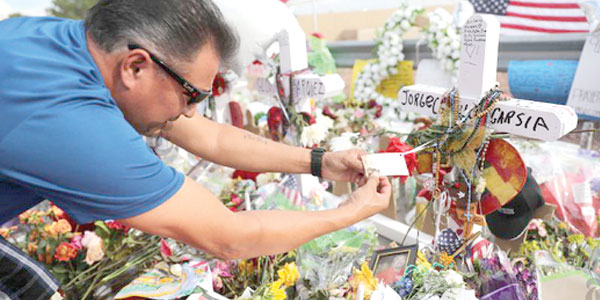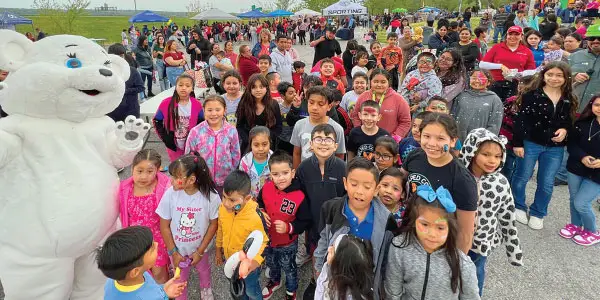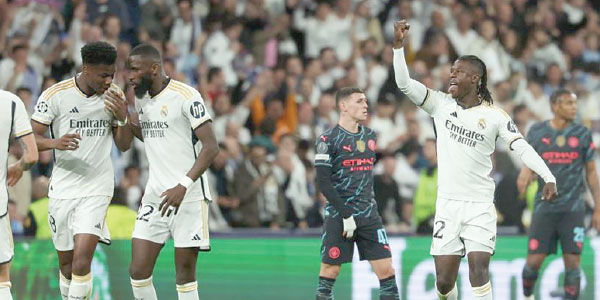
By Jorge Ramos
EL PASO — “I don’t know why he took my boy’s life,” Dora Lizarde said. Her grandson Javier, 15, was the youngest victim of last weekend’s massacre, killed by a bullet to the head. “Fifteen years old; he still had so much time to live,” Ms. Lizarde told me in an interview this week. “I don’t know why he took him away, I don’t understand. He is young too.”
Patrick Crusius is young, too.
Police have charged Mr. Crusius, 21, in the mass shooting that killed 22 people at a crowded Walmart here on Aug. 3. Nineteen of the victims had Spanish surnames, making this the worst attack on Latinos in modern American history. The Mexican government has labeled the killings a terrorist act, given that eight Mexican citizens were among the dead. And, yes, it is a hate crime.
The massacre of Latinos in El Paso is the latest and most brutal reaction by a young, white American against a future that might be dominated by minorities. The fact that this attack happened is unsurprising: What else can we expect when racism and hatred of others is promoted from the top down in a country where there are more guns than people?
Authorities have said thatMr. Crusius posted a 2,300-word manifesto online minutes before the attack, in which he tried to justify his actions, a “Hispanic invasion of Texas” being one of his reasons. “It makes no sense to keep letting millions of illegal or legal immigrants flood into the United States,” Mr. Crusius allegedly wrote, “and to keep the tens of millions that are already here.” Those words startled me — not only because they were so hateful, but because they could seamlessly fit into any speech given by President Trump, a member of his cabinet or any of several right-wing politicians.
While Mr. Trump insists that he does not have “a racist bone” in his body, his history of making racist remarks says otherwise. After years of insinuating that President Barack Obama had not been born in the United States, Mr. Trump launched his presidential campaign in 2015 by likening Mexican immigrants to criminals and rapists. He recently said that four congresswomen of color should “go back” to the countries from which they came. The list goes on, and when the most powerful man in the world is repeating such rhetoric, we should not be surprised when others mimic him.
Beto O’Rourke, the former congressman from El Paso and a Democratic presidential candidate, recently told me that he is convinced Mr. Trump influenced the attack. Mr. O’Rourke — who along with Senator Elizabeth Warren, another Democratic candidate for the presidency, has said that Mr. Trump is a “white supremacist” in recent days — responded to a tweet from the president by writing: “22 people in my hometown are dead after an act of terror inspired by your racism. ”Other leaders and politicians, including Representative Alexandria Ocasio-Cortez, have also lost their patience with Mr. Trump. “I don’t want to hear the question ‘Is this president racist?’ anymore. He is,” Ms. Ocasio-Cortez said recently.
The president’s xenophobia, and that of many of his supporters and enablers, is rooted in a dread that the day is soon coming when they will be a minority in their own country. While non-Hispanic whites remain a majority of the population in the United States, in less than 30 years that may no longer be the case, according to projections. This sort of demographic revolution is putting Americans’ tolerance to the test. Most of us welcome an increasingly diverse country, but many, like Mr. Trump, resist the country’s multiethnic, multicultural future. Some react by walking into a store to murder innocent people.
The most racist Americans who are set on killing minorities are aided by the fact that they can easily obtain assault weapons in this country. I’ve lost count of all the massacres I’ve covered as a journalist. After each shooting — Columbine, Sandy Hook, Las Vegas, Parkland ― I thought we might have reached the limit of Americans’ tolerance for such horror. But it wasn’t so. I fear that the killings in El Paso won’t change anything, and that I soon will be back on another flight headed to cover the next massacre. And then another. And another after that.
I have lost hope that the United States will ever pass laws that limit access to firearms. Like many parents around the country, I’ve had difficult conversations with my children in case they find themselves in a situation where someone is shooting at them. “Try to escape, hide or fight,” I tell them. “But don’t stay still. Gunmen have a lot of bullets, but not patience.”
Still, even if we could somehow solve our gun problem in America, our racism problem would be far more difficult to eradicate. Hate-group activity is on the rise, according to the Southern Poverty Law Center. And anti-immigrant rhetoric has already appeared in slogans shouted during the 2020 presidential campaign.
I crossed the border from El Paso to Ciudad Juárez, Mexico, one morning this week. For many years, Juárez was considered one of the most dangerous cities in Mexico because of the presence of drug cartels. Yet on this visit some people I spoke with told me that they didn’t dare cross into El Paso with their families. When I asked why, some said that they feared being hunted for being Mexican, and all said that racism was a factor.
Nobody should live in fear because they are Mexican or Latino. But that’s where we are now in this United States of Trump. There is an indisputable connection between the abundance of weapons of war on the streets and Mr. Trump’s unending, racist rhetoric, on the one hand, and the massacre in El Paso, on the other. What happened in this city was a massacre foretold.
Words matter. When they are filled with hate, they cause great damage.
__________________________________________________________________________
Temo que las muertes en El Paso no cambien nada
NADIE DEBERÍA TENER MIEDO POR HABER NACIDO MEXICANO O LATINO. PERO A ESO HEMOS LLEGADO EN LOS ESTADOS UNIDOS DE DONALD TRUMP.
EL PASO, Texas — “No sé por qué le quitó la vida a mi niño de 15 años”, me dijo entre sollozos Dora Lizarde, la abuela de Javier Rodríguez, la víctima más joven de la masacre en esta ciudad fronteriza y quien murió de un tiro en la cabeza. “Tenía mucho tiempo para vivir, no sé por qué se lo llevó. No lo voy a ver jamás. No lo entiendo, si él también está joven”.
Sí, Patrick Crusius, de 21 años de edad , es joven y fue acusado de asesinar a veintidós personas el pasado 3 de agosto. Diecinueve de los veintidós muertos tienen apellidos hispanos. Se trata, por lo tanto, del peor ataque dirigido específicamente contra latinos en la historia moderna de Estados Unidos. El gobierno de México lo ha calificado como un “acto terrorista” (ya que entre los muertos hay ocho ciudadanos mexicanos). Y es, también, un crimen de odio.
La matanza de latinos en El Paso, Texas, es la expresión de rechazo más brutal y violenta frente a un futuro estadounidense dominado por minorías. Es lo que pasa cuando el odio racial se promueve desde arriba hacia abajo en un país donde hay más armas que personas.
Minutos antes de irrumpir en Walmart, según las autoridades, Crusius publicó en línea un “manifiesto” en el que justificaba su acción. Escribió que el ataque era en respuesta a la “invasión hispana de Texas”. Al leer el documento de 2300 palabras, un párrafo me saltó. Decía: “No tiene ningún sentido permitir que inmigrantes ilegales o legales inunden Estados Unidos, ni permitir que se queden decenas de millones que ya están aquí”. Esas palabras podrían perfectamente escucharse en un discurso del presidente de Estados Unidos, Donald Trump, de miembros de su gabinete o de algunos políticos de la derecha.
El problema es este: las palabras de Trump y las de Crusius se confunden. Cuando ambos hablan de “invasión” y exponen su visión negativa sobre los inmigrantes, es difícil saber de qué boca están saliendo.
Estados Unidos tiene un Presidente que al menos dos candidatos presidenciales —Elizabeth Warren y Beto O’Rourke— han calificado como “nacionalista blanco”. Trump, obviamente, no lo ve así. “Soy la persona menos racista que hayas conocido”, dijo en una ocasión. Pero yo recuerdo perfectamente cuando dijo que los inmigrantes mexicanos —y yo soy un inmigrante mexicano— éramos criminales y violadores.
Esos son comentarios racistas, vienen del hombre más poderoso del mundo y no debe sorprendernos que otros los repitan.
El excongresista y aspirante presidencial Beto O’Rourke me dijo en una entrevista que él está convencido de la influencia del presidente Trump en la masacre de El Paso. En un mensaje de Twitter, dirigido a Trump, O’Rourke escribió: “Veintidós personas de mi comunidad están muertas por un acto de terror inspirado por su racismo”.
Otros líderes y políticos, como la congresista Alexandria Ocasio-Cortez, también ya han perdido la paciencia con Trump. “Ya no quiero, de nuevo, oír la pregunta de si el Presidente es un racista. Sí lo es”, dijo en un discurso.
La xenofobia presidencial y la de millones de sus seguidores viene del temor de convertirse en minoría en su propio país. Los blancos (no hispanos) aún son mayoría en Estados Unidos. Pero en menos de treinta años ya no lo serán. Se trata de una verdadera revolución demográfica que está poniendo a prueba la tolerancia de millones de estadounidenses. Aunque muchos le dan la bienvenida a un país cada vez más diverso, otros, como Trump, se resisten a un destino multiétnico y multicultural.
A golpes se me ha esfumado la esperanza de que Estados Unidos controle y limite el uso de armas. Ya perdí la cuenta de todas las masacres que he cubierto como periodista. Después de cada matanza —Columbine, Sandy Hook, Las Vegas, Parkland— creí que habíamos llegado al límite. Pero no fue así. Temo que las muertes en El Paso no cambien nada. Y que pronto tenga que subirme a otro avión para cubrir la siguiente masacre y la siguiente y la siguiente. Como padre, ya tuve esa difícil conversación con mis hijos: si les toca un tiroteo —les dije— traten de escapar, escóndanse o peleen. Pero no se queden inmóviles. Los pistoleros van cargados de balas, no de paciencia.
Se puede resolver el problema de las armas, pero el creciente racismo en Estados Unidos es aún más difícil de erradicar. Los grupos de odio han crecido en los últimos cuatro años, según el Southern Poverty Law Center. Y la retórica antiinmigrante va a terminar en gritos durante la campaña presidencial de 2020.
Estamos en una temporada de odio.
Una mañana crucé la frontera de El Paso a Ciudad Juárez, en Chihuahua. Sobra decir que Juárez fue considerada durante muchos años una de las ciudades más peligrosas de México y de todo el hemisferio por la presencia de los cárteles de las drogas. La gran ironía es que, tras la masacre en Texas, algunos habitantes de Ciudad Juárez me dijeron que no se atrevían a cruzar a El Paso con sus familias. Temían ser cazados o discriminados por el simple hecho de ser mexicanos. ¿Por qué no quieren ir a Estados Unidos?, les pregunté. La palabra “racismo” estuvo en casi todas sus respuestas.
Nadie debería tener miedo por haber nacido mexicano o latino. Pero a eso hemos llegado en los Estados Unidos de Donald Trump. Lo que ocurrió en El Paso fue una masacre anunciada. Más allá de la absurda abundancia de armas de guerra en las calles, hay un hilo narrativo (feroz e inequívoco) desde las palabras de Trump en aquel julio de 2015 —“son violadores”— hasta la matanza en El Paso en este agosto de 2019.
Las palabras importan. Y, cuando van cargadas de odio, hacen muchísimo daño.
Jorge Ramos es periodista, conductor de los programas Noticiero Univisión y Al punto y autor del libro Stranger: El desafío de un inmigrante latino en la era de Trump. Con este artículo, se inicia una serie de colaboraciones regulares para la serie Latinos 2020.









